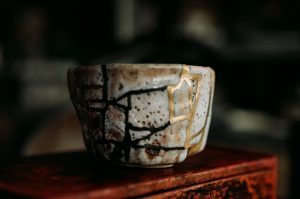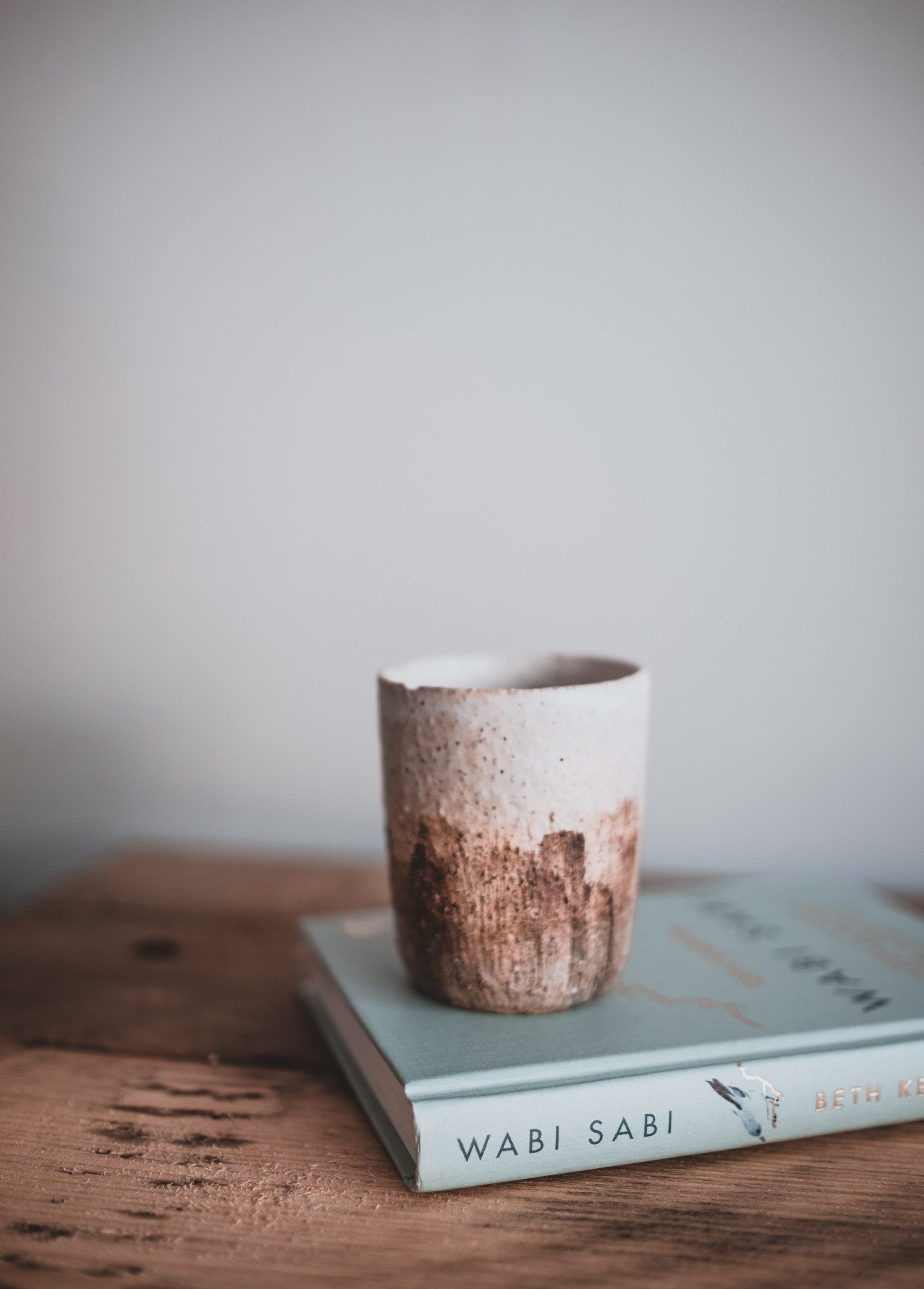Many years ago, I bought a large mug at a pottery shop for local artisans in St. Paul, Minnesota. It was on the discount rack, priced about $5, I think, well within my graduate-student budget and noticeably under the average price point of such things on offer. It was big and beefy and glazed with an appealing palette of lavender and browns, perfect for massive doses of coffee. When I discovered the perfectly intact thumbprint smack on its side, I knew why it was in the discount bin. Yet to my eyes, that glaring “flaw” was better by far than the artist’s scribble on the bottom. It was the undeniable imprint of the human being who had made it, a unique individual captured at a specific moment in time. I could almost hear the potter’s exhaled, “Damn!” In that same moment, that object became literally one of a kind. The mug spoke to me: “I have a history, a life of my own.” I knew that I just had to have it.
The Japanese have long appreciated the beauty, richness, and meaning to be found in the flaw, the imperfection, things most Westerners abhor. They call it wabi sabi, an aesthetic derived from Zen Buddhist principles, and in the simplest terms, it reflects a recognition and acceptance of the imperfection and impermanence of life. I won’t insult the depth of this profound philosophy and practice by trying to explain it or treat it like some decorating trend. There are many good resources to learn more about it, including the recent article I’ve linked at the end of this post. Suffice it to say here, the term is essentially untranslatable in English, which is a dead giveaway that it’s something European-identified folks don’t easily “get.”
Antiques, of course, perfectly exemplify the imperfect, with all their bumps and bruises, wear and tear, and decay earned over many years. An old object often carries on its surface the marks of human beings it has encountered along the way, for better or for worse. But that record, usually called “damage” in the trade, is the narrator of its story. Some collectors tolerate no or virtually no damage. Museum pieces are also usually the most perfect examples of any thing, but significantly, these are also the ones pulled out of the stream of real life. In a way, once the perfect examples are encased, they die.

Kintsugi, “golden joinery.” Photo Motoki Tonn on Unsplash.com.
Kintsugi is a lovely and ancient wabi sabi practice (also Japanese) of repairing broken things, usually pottery. Rather than hide a break, kintsugi calls attention to the damage using the most precious material around: gold. In this way, the object reminds us that fragile things get broken, porcelain as well as people, but they can recover and live again more beautifully because of the experience.
In Europe, after the porcelain code was cracked at Meissen in the early 18th century, everyday people in the West could enjoy more china items in more everyday ways and thus they broke a lot of teacups and dishes over the years. Porcelain and other china goods were still expensive and thus precious in the 18th and 19th centuries, though, so an accident would have to be truly catastrophic to warrant throwing a piece away. China mending became a highly skilled trade, often using the ingenious staple method (yes, also Asian in origin). If you’ve never seen a stapled dish, check out Andrew Baseman’s gorgeous post, “Stapled Bowl with Birds and Insects, c. 1830,” on his fascinating blog, Past Imperfect: The Art of Inventive Repair, http://blog.andrewbaseman.com/?p=11501.
Alas, by the time I bought my mug in late 20th-century America, the West had fully embraced the disposable lifestyle and my mug was broken and thrown away at some point. I don’t even remember exactly what happened to it or when, just that I do not have it anymore. And now even that is part of its story, too. All products of human activity, even the well-loved and admired ones, are passing away in the big picture of things. Sometimes no amount of care and skill can fix the damage or resurrect a piece from utter loss. Decay, breakage, destruction—despite our best efforts, these experiences will almost certainly become part of every breakable thing’s life story eventually. And like our own lives, it is our imperfections and rough patches that tell the story of our existence.
Cover photo: Annie Spratt on Unsplash.com
Read More:
“What Is Wabi Sabi? The Elusive Beauty of Imperfection,” by Anne Walther, January 8, 2021,
https://japanobjects.com/features/wabi-sabi

